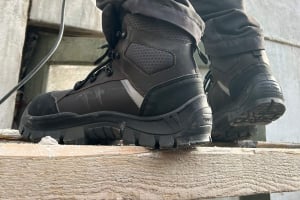
How to protect yourself from UV rays?
Summary
Types of UV (Ultraviolet)
What are the 3 types of UV?
The ultraviolet (UV) rays are part of the light spectrum emitted by the sun, invisible to the naked eye. They are classified into three categories based on their wavelength: UVA, UVB and UVC.
UVC is completely absorbed by the Earth's atmosphere, but UVA and UVB reach the surface and have significant impacts on our skin and eyes.
UVA
These are the most common UV rays and make up about 95% of UV rays that reach the Earth's surface. UVA can penetrate deep into the skin and contributes to premature skin aging and wrinkles. They are also responsible for tanning. UVA can pass through windows and is present all day long and all year round.
UVB
UVB rays are more dangerous than UVA rays. Although less common than UVA, it is more energetic and can directly damage the DNA of skin cells, leading to sunburn and most skin cancers. The intensity of UVB rays varies depending on the time of day and year. They are strongest between 10 a.m. and 4 p.m. and from the spring equinox to the autumnal equinox.
UVC
UVC is the most dangerous of all UV rays. Fortunately, they are completely absorbed by the Earth's atmosphere and do not reach the Earth's surface. UVC is used artificially in some germicidal lamps for its ability to kill bacteria and viruses.
What are harmful UV rays?
All types of ultraviolet (UV) rays can be harmful to humans. However, under normal conditions, only UVA and UVB reach the Earth's surface and pose a threat to our skin and eye health. UVC, although the most dangerous, is generally absorbed by the Earth's atmosphere and does not affect us directly.
Why are UV rays dangerous?
It is important to note that although UVC does not reach the Earth's surface, UVA and UVB do and can cause damage to the skin and eyes. This is why it is crucial to protect yourself from these rays, in particular by using broad-spectrum sunscreen, work clothing protectors and sunglasses.
Ultraviolet (UV) rays can be dangerous to human health for several reasons:
- Skin damage
- Eye damage
- Suppression of the immune system
How to protect your eyes from UV rays?
It is equally important to protect your eyes. Wearing protective glasses is essential when outdoors, especially during times when the sun is the strongest. It is recommended to choose glasses that block 100% of UVA and UVB rays. Some manufacturers also offer lenses with an anti-UV coating for additional protection.
Protect your body with anti-UV clothing
In addition to sunscreen and sunglasses, it is possible to protect yourself from UV rays by wearing suitable clothing. Clothing is an effective physical barrier against UV rays, and some are specially designed to provide sun protection.
UV protective clothing is made from fabrics that have been laboratory tested to determine their ability to block UV rays. The result of this test is expressed in UPF (Ultraviolet Protection Factor). A UPF of 50 means that the fabric only allows 1/50th of UV rays to pass through. That is, the higher the UPF, the better the protection.
It is recommended to choose clothing that covers as much skin as possible. Long-sleeved shirts, long pants and wide-brimmed hats are therefore preferable.
However, not all clothing is equally effective at blocking UV rays. For example, thick, dense fabrics, like denim or wool, block more UV rays than thin, lightweight fabrics like linen or silk. Likewise, dark colors absorb more UV rays than light colors.
It is important to note that clothing cannot block all UV rays and therefore should not be the only measure of sun protection. It is always necessary to use additional equipment such as anti-UV glasses.
Protect yourself against the dangers of UV radiation
UV rays are an invisible part of the sun's light spectrum that can cause damage to our skin and eyes. They are stronger in summer, at high altitudes, and can be reflected by water, snow and sand, increasing exposure.
Sun creams, sunglasses and anti-UV clothing are valuable tools to protect us from UV rays.
However, appropriate education and awareness is also necessary to ensure that we use them correctly and regularly.






